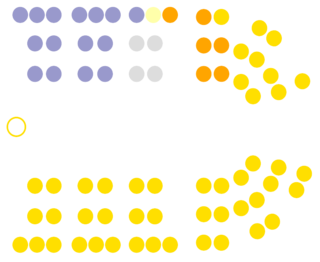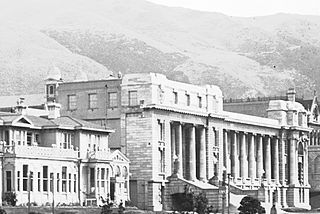
The 1893 New Zealand general election was held on 28 November and 20 December in the European and Māori electorates, respectively, to elect 74 MPs to the 12th session of the New Zealand Parliament. The election was won by the Liberal Party, and Richard Seddon became Prime Minister.

The 1896 New Zealand general election was held on Wednesday, 4 December in the general electorates, and on Thursday, 19 December in the Māori electorates to elect a total of 74 MPs to the 13th session of the New Zealand Parliament. A total number of 337,024 (76.1%) voters turned out to vote.

The 1899 New Zealand general election was held on 6 and 19 December in the European and Māori electorates, respectively, to elect 74 MPs to the 14th session of the New Zealand Parliament. The election was again won by the Liberal Party, and Richard Seddon remained Prime Minister.

Invercargill is an electorate of the New Zealand Parliament that has existed since 1866. Since the 2020 election, the electorate's representative is Penny Simmonds of the National Party.

William Earnshaw was a New Zealand Member of Parliament for two Dunedin electorates representing the Liberal Party. He later served on the Legislative Council. He was one of the first labour representatives in Parliament.

James Colvin was a New Zealand Member of Parliament for Buller, in the South Island.
Avon is a former New Zealand parliamentary electorate. It was created for the 1861 general election and existed until 1996. It was represented by 13 Members of Parliament and was held by Independents, Liberal Party or Labour Party representatives.
Thames is a former New Zealand electorate, in the Thames-Coromandel District. It existed from 1871 to 1946.
Kaiapoi was a rural New Zealand electorate, north of Christchurch in the Canterbury region of New Zealand from 1861 to 1946. It was represented by twelve Members of Parliament.

William Francis Buckland was a 19th-century Member of Parliament in New Zealand, an independent conservative MP and cricketer.
James Mackintosh was a 19th-century Liberal Party Member of Parliament in Southland, New Zealand.

The 11th New Zealand Parliament was a term of the Parliament of New Zealand.

The 12th New Zealand Parliament was a term of the New Zealand Parliament. It was elected at the 1893 general election in November and December of that year.

The 14th New Zealand Parliament was a term of the New Zealand Parliament. It was elected at the 1899 general election in December of that year.

The 15th New Zealand Parliament was a term of the New Zealand Parliament. It was elected at the 1902 general election in November and December of that year.

The 16th New Zealand Parliament was a term of the New Zealand Parliament. It was elected at the 1905 general election in December of that year.

The 21st New Zealand Parliament was a term of the New Zealand Parliament. It was elected at the 1922 general election in December of that year.

The 23rd New Zealand Parliament was a term of the New Zealand Parliament. It was elected at the 1928 general election in November of that year.

The 26th New Zealand Parliament was a term of the New Zealand Parliament. It was elected at the 1938 general election in October of that year.
The City of Christchurch by-election of 1896 was a by-election held on 13 February 1896 during the 12th New Zealand Parliament in the urban seat of the City of Christchurch. The by-election was triggered by the appointment of William Pember Reeves as Agent-General to the United Kingdom. The Liberal Government led by Richard Seddon had trouble finding a suitable candidate and delayed Reeves' resignation until the day he left his home in Christchurch to take up the London post. Nonetheless, rumours of Reeves' pending resignation had been circulating for a month and candidates were lining up. The Liberal Party candidate who was secured resigned within a week of Reeves' eventual resignation, and a new candidate had to be found. Three candidates contested the election: Richard Molesworth Taylor was the official Liberal Party candidate, Tommy Taylor was a prohibitionist also with liberal views but an ardent opponent of Seddon, and Charles Lewis was the reluctant conservative candidate of the opposition. Being a Liberal Party stronghold, vote splitting between those candidates who held liberal views secured the election win for Lewis, with the Liberal Party candidate coming last.










